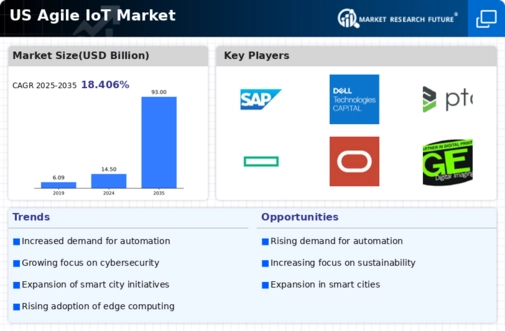The agile IoT market is currently characterized by a dynamic competitive landscape, driven by rapid technological advancements and increasing demand for interconnected devices. Major players such as Amazon (US), Microsoft (US), and IBM (US) are at the forefront, each adopting distinct strategies to enhance their market positioning. Amazon (US) focuses on expanding its cloud services, leveraging its AWS platform to integrate IoT solutions seamlessly. Microsoft (US) emphasizes partnerships and collaborations, particularly in the realm of AI and machine learning, to enhance its Azure IoT offerings. IBM (US), on the other hand, is heavily investing in research and development, particularly in edge computing, to provide innovative solutions that cater to diverse industry needs. Collectively, these strategies contribute to a competitive environment that is increasingly centered around innovation and technological integration.
In terms of business tactics, companies are localizing manufacturing and optimizing supply chains to enhance operational efficiency. The market structure appears moderately fragmented, with a mix of established players and emerging startups. This fragmentation allows for a diverse range of solutions, although the influence of key players remains substantial, shaping industry standards and customer expectations.
In October 2025, Amazon (US) announced the launch of a new IoT service aimed at enhancing smart home integration, which is expected to streamline user experiences across various devices. This strategic move not only reinforces Amazon's commitment to the smart home segment but also positions it to capture a larger share of the growing consumer IoT market. The integration of advanced AI capabilities into this service may further enhance its appeal, suggesting a potential shift in consumer preferences towards more intelligent home solutions.
In September 2025, Microsoft (US) unveiled a significant upgrade to its Azure IoT platform, incorporating advanced analytics and machine learning features. This enhancement is likely to attract more enterprise customers seeking to leverage data-driven insights for operational efficiency. By focusing on AI integration, Microsoft appears to be solidifying its position as a leader in the enterprise IoT space, potentially outpacing competitors who may not prioritize such technological advancements.
In August 2025, IBM (US) entered into a strategic partnership with a leading automotive manufacturer to develop IoT solutions for connected vehicles. This collaboration is indicative of IBM's strategy to penetrate high-growth sectors, such as automotive, where IoT applications are becoming increasingly critical. The partnership not only enhances IBM's portfolio but also reflects a broader trend of cross-industry collaborations aimed at driving innovation and expanding market reach.
As of November 2025, current trends in the agile IoT market are heavily influenced by digitalization, sustainability, and the integration of AI technologies. Strategic alliances are becoming increasingly vital, as companies recognize the need to collaborate to stay competitive. Looking ahead, it is anticipated that competitive differentiation will evolve, shifting from traditional price-based competition to a focus on innovation, technological advancements, and supply chain reliability. This transition underscores the importance of agility and adaptability in a rapidly changing market landscape.

















Leave a Comment